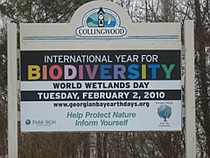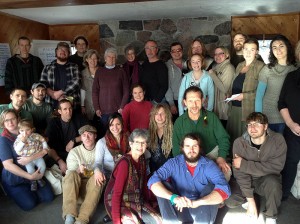Archive for December, 2014
Transition Meaford and Transition Collingwood create blueprint for healthy community
“In the leaking ship that we’ve made of our planet, the Transition movement is like a flotilla of life rafts. And they’ve come not to pull us off the earth, but to help us patch it and make it right.”
– Bill McKibben
In early December fourteen people from the Meaford and Beaver Valley area came together to continue to work on making their community a healthier and more self-reliant place to live. I had attended a meeting of Transition Meaford two years previously and found that there is a growing interest amongst the townspeople in creating a more engaged society so that people and the rest of Nature can flourish.
In 2013, Meaford Council adopted the recommendation by Transition Meaford to have an Earth Week. This took place in April 2014, beginning with a spring clean-up at Memorial Park, and ending with a Re-use Fair. Lindy Iversen and other Transition Meaford people were on hand to volunteer. The tradition will continue in 2015.
Transition Meaford has been involved in a number of other projects. The group has played a significant part in the community garden at the high school. Films for Thought was set up to promote greater awareness of social justice and ecology around the world, through screenings of films that gave the community insight into ongoing struggles related to food, water, community design and waste. The Bee and Butterfly Habitat Initiative brought to the forefront the plight of our pollinators.
The group would love to meet other Meaford and area residents who care about the future of their community. Meetings are held on the second Wednesday of each month at 7pm at EcoInhabit on Old Highway 26, east of Meaford. Next meeting is on January 14th. To find out more, visit www.transitionmeaford.org
Live in Collingwood? Transition Collingwood’s initiatives can be found at transitioncollingood.com
How did the Transition movement come about?
Back in 2005 people in Totnes, UK began to ask themselves how they could thrive in the face of climate instability and oil scarcity, and thus the first Transition Town was born. The vision of a resilient community that could support itself culturally and agriculturally despite the problems raised by these twin threats inspired the Transition Network, which has spread within ten years to encompass the world. By not having any political affiliations the movement has been able to gain the trust of entire communities. This has led to close working with all segments of society.
To the amazement of founder Rob Hopkins, the accomplishments of the expanding Transition Community now include social justice issues as well. Places like Brazil and India are more interested in alleviating poverty and empowering women than discussing northern concerns for climate change mitigation strategies. The Transition movement is embracing more and more topics that impact the health of communities, to create a Transition Culture that looks at the causes of consumerism and the growth economy and changes the very soil of the community’s culture and inner life. It transitions towns to the ‘caring economy’. (It must be noted that the opposite of this is shown in the lack of balance and compassion in Canada’s skewed oil-based economy.)
Several towns and cities now have their own local currencies, which encourage their communities to buy locally produced goods and thereby recycle their money to keep their own businesses vibrant. The benefits come full circle. The city of Bristol, in Britain, even pays its mayor in Bristol Pounds! Having a local currency has fostered a deep sense of trust in the community. Bristol has now won the prestigious award of European Green Capital 2015.
Please visit www.transitionnetwork.org to learn more about the Transition movement.
Kimbercote Farm’s AGM brings out the best in our community
Kimbercote Farm is located on a hill that looks down on the Beaver Valley and beyond. For the past 40 years it has provided physical and spiritual space for people to grow. It’s brochure describes the Farm as a “Centre for social and environmental justice in the heart of the Beaver Valley”. The Farm’s 110 acres has provided the Georgian Bay and Southern Ontario communities with a unique opportunity to experience a country setting for events, retreats and a vast array of discussions that take place because of the dedicated volunteers who have kept Kimbercote alive and well with their creative zeal for four decades. Although the focus of the Farm’s activities may have shifted through the decades social justice has always been the bedrock for all its charitable not-for-profit work. As the meaning of social justice has expanded in the last 40 years, so has inclusion of nature stewardship become more important to the Farm. Gardening, permaculture, forest ecology programs, the truly hands-on efforts by Sticks & Stones Wilderness School plus Headwaters Gathering groups have put new meaning into conservation education and practices in sustainability. And so Kimbercote has championed and nurtured aboriginal culture, organic agriculture, faith/spiritual groups, children, families as well as men and women’s retreat groups. The farmhouse has been the key to letting the Farm host year round 25 guests at a time plus tents.
The Annual General Meeting on December 7 brought out 60 individuals of all age groups. No one has ever seen such a large group come out to such a meeting at the Farm. Kimbercote Farm is in financial trouble but it is not without its friends. This place means a great deal to many people. This year’s AGM brought out the people for the love of a Georgian Bay community icon. The usual AGM business of voting in board members was not the focus of the meeting so much as an inspired discussion on the future for the charity. Although the current debt is quite small fewer groups are renting the space in an ageing farmhouse but the maintenance of the facilities keeps on growing.
The members attending the meeting were asked to have small discussion groups and write out their suggestions to be presented to the new board of directors who will then make the critical decisions as to the Farm’s future. Three proposals were given to the group. Naturally the community wishes to see a vibrant and financially secure future for the Farm. Thoughts of renting out the farmhouse on a yearly lease, seeing the sale of some acreage to conservation groups and having Sticks & Stones Wilderness School play a more active role in programming may be the starting point for the end of the charity’s woes.
The crisis now being experienced can transform Kimbercote into the Centre for Community and Ecology, as mentioned at the AGM, and give true meaning and tangible direction to the founders’s original goals of social justice. A possibility/option exists to sell the facility and purchase a new one which puts a major focus onto program development for youth and families, provide dialogue with other communities and “support community/ecology locally, regionally and provincially.” Programs would start in early 2015 for children. SSWS would share programming efforts also. A legal trust would also be created to insure “trust funds go to social justice innovators if the sale of property occurs in the future.”
The other option spells the sale of the land and basically giving the money to like-minded foundations. The new Board’s occupation will be one of courage and vision. We wish them wisdom. It is more than just putting into place short term financial solutions. Kimbercote’s core community needs to now put into play the creative ideas and passion to bring it to 2050.
If you wish to learn more about the Farm and perhaps help in various ways please visit:
www.kimbercote.org or write to info@kimbercote.org


